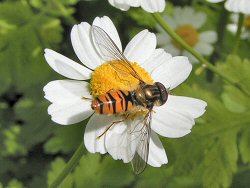When it comes to garden wildlife, it pays to take a really close look from to time.
This is particularly true of insects, which comprise the majority of animals we encounter in the garden. Insects are many times smaller than other forms of garden wildlife like birds and mammals. Their size and the scale at which they operate are so alien to us that it is all too easy to overlook them and miss some of the fantastic detail of the amazing lives they lead right under our noses.
 Puparium of a hoverfly found on aphid infested sweet peas (Lathyrus odoratus)
Puparium of a hoverfly found on aphid infested sweet peas (Lathyrus odoratus)
By making a conscious effort to 'tune-in' to the world at their scale, you soon become aware that every flower bed or pot is a veritable jungle!
This year I planted a pot of sweet peas (
Lathyrus odoratus) - a favourite of my wife - outside the back door. Their beautiful scent has been a wonderful greeting as we enter the garden. Evidently we are not the only ones that have found them irresistible, since they have attracted good numbers of aphids for the past three or four weeks.
 Marmalade hoverfly (Episyrphus balteatus)
Marmalade hoverfly (Episyrphus balteatus)
Aphids no longer send me battle stations (as they once would have done); nowadays I look at them more as food for other garden animals. Many birds and a whole industry of insects use aphids as a source of food: ladybirds and many hoverflies are among the best known.
A few days ago I had a really close at the plants and noticed a small caterpillar-like animal. I suspected that it was the larva of a hoverfly. Yesterday, I looked again and although I couldn't see the larva, I noticed a couple of teardrop-shaped objects about the same size. These are puparia of hoverfly larva. The puparium (formed from the hardened larval skin) contains the actual pupa which is the transitory stage between the larva and adult. According to
Gilbert 1986, these teardrop puparia are typical of aphid-feeding hoverflies and normally last around 10 days. I collected the pair of them and put them in a ventilated tank - I look forward to seeing what emerges - perhaps it will be the marmalade fly (
Episyrphus balteatus) or maybe the equally common hoverfly
Syrphus ribesii. Watch this space!